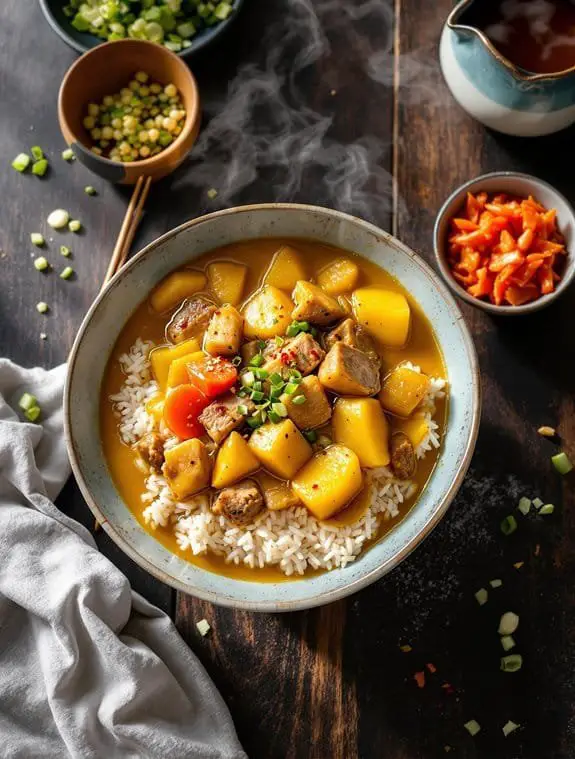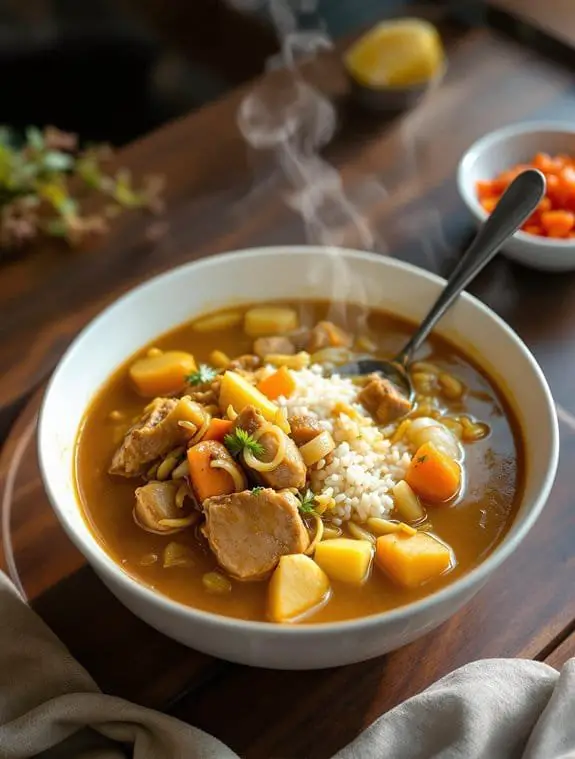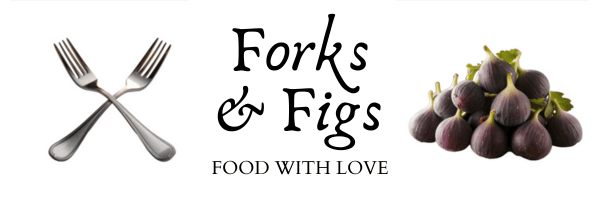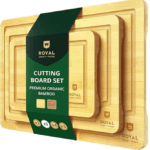Comforting Korean Curry Rice Recipe: A Homestyle Favorite

I’ll be honest with you – when life gets chaotic and I need something that feels like a warm hug in a bowl, Korean curry rice is my go-to. It’s one of those dishes that doesn’t require fancy techniques or hard-to-find ingredients, yet somehow manages to deliver maximum comfort with minimal fuss. But here’s the thing most people don’t realize about making authentic Korean curry at home.
Why You’ll Love this Comforting Korean Curry Rice
When you’re craving something warm, filling, and ridiculously easy to make, Korean curry rice swoops in like a superhero with a cape made of golden, creamy sauce.
This isn’t your grandmother’s three-hour stew situation. We’re talking about a one-pot wonder that transforms basic ingredients into pure comfort food magic.
I love how forgiving this recipe is.
Potatoes slightly overcooked? No problem.
Vegetables cut unevenly? Who cares when everything’s swimming in that velvety curry goodness.
Plus, you probably have most ingredients already sitting in your kitchen, just waiting to become dinner.
What Ingredients are in Comforting Korean Curry Rice?
The beauty of Korean curry rice lies in its simplicity, and that starts with a surprisingly short ingredients list. We’re not talking about hunting down exotic spices or making three trips to specialty stores. Most of these items are probably hanging out in your pantry or fridge right now, just waiting to be transformed into something magical.
The star player here is Korean curry powder, which does all the heavy lifting when it comes to flavor. Unlike making curry from scratch with dozens of individual spices, this powder is your shortcut to that rich, slightly sweet, and warming curry taste that makes Korean curry so distinctive and comforting.
Ingredients:
- 2 tablespoons unsalted butter
- ½ pound pork loin (or beef/chicken)
- 2 medium potatoes, peeled and cubed
- 1 large onion, cubed
- 1 medium carrot, peeled and cubed
- 3 cups water
- 100 grams Korean curry powder
- Steamed white rice
Ingredient Notes and Substitutions
Let’s talk about that Korean curry powder first, since it’s probably the one thing you might need to actually go shopping for. You can find it at most Asian grocery stores, and honestly, it’s worth seeking out the real deal. The flavor is milder and sweeter than Indian curry powder, with that distinctive taste that makes Korean curry so addictive.
When it comes to the meat, pork loin is traditional, but don’t stress if you’ve got chicken thighs or beef stew meat in your freezer instead. The curry sauce is so flavorful that it’ll make any protein taste amazing. Just adjust your cooking time accordingly, especially if you’re using tougher cuts of beef.
For the vegetables, consistency in your cube sizes matters more than perfection. Aim for roughly inch-sized pieces so everything cooks evenly. If your knife skills are more “rustic charm” than “professional chef,” that’s totally fine. The curry will still taste incredible, even if your potatoes look like they were cut by someone wearing oven mitts.
How to Make this Comforting Korean Curry Rice

Making this Korean curry rice is honestly one of those recipes that feels like you’re getting away with something. The whole process is so straightforward, yet the results taste like you’ve been simmering something complex all afternoon. Let me walk you through it step by step, because once you see how simple this is, you’re going to wonder why you haven’t been making it every week.
Start by mixing your 100 grams of Korean curry powder with ½ cup of water in a small bowl. This creates what I like to think of as your flavor paste, and setting it aside now means you won’t be frantically trying to mix it later while your vegetables are threatening to overcook. The mixture will look thick and slightly lumpy, which is exactly what you want.
Next, grab a decent-sized pot and melt 2 tablespoons of unsalted butter over medium-high heat. Don’t rush this part by cranking the heat too high, because burnt butter tastes bitter and will throw off your entire curry. Once the butter is melted and maybe just starting to foam a little, add your ½ pound of pork loin and cook it until it’s no longer pink on the outside.
Here’s where things get interesting. Add those 2 medium potatoes you cubed earlier and cook them until they start looking semi-translucent around the edges. This usually takes about 3 to 4 minutes, and you’ll know you’re on the right track when the potato pieces start looking slightly glossy instead of that raw, chalky white they start with.
Toss in your 1 medium carrot and 1 large onion, both cubed, and give everything a quick sauté. You’re not trying to cook these vegetables completely at this stage, just getting them acquainted with the heat and starting to release some of their natural sweetness. A minute or two is plenty here.
Now comes the part where your kitchen starts smelling absolutely incredible. Pour in 2½ cups of water, cover the pot, and let everything simmer for 10 to 12 minutes until those potatoes are fork-tender. The water should be bubbling gently, not at a rolling boil that might break apart your vegetables before they’re properly cooked.
Finally, stir in that curry mixture you prepared earlier. This is the moment when your simple pot of vegetables transforms into something that actually looks and smells like proper curry. Keep stirring until the sauce becomes creamy and everything is heated through, which usually takes just a couple of minutes.
The beauty of this recipe is in its timing. Everything happens in a logical sequence, and there’s no juggling multiple pots or worrying about complex techniques. Just meat, then vegetables in order of how long they need to cook, then water, then that magical curry paste that brings it all together.
Serve your curry sauce over steamed white rice, and if you really want to do this right, have some kimchi on the side. The tangy, spicy crunch of kimchi against the rich, mild curry is one of those flavor combinations that makes perfect sense once you try it, even if it sounds a little odd on paper.
Comforting Korean Curry Rice Substitutions and Variations
If you’re anything like me, you probably open your fridge, stare at whatever random ingredients are lurking in there, and wonder if you can somehow make them work in this curry.
Good news: this recipe’s incredibly forgiving. Swap pork for whatever protein you’ve got, chicken thighs, beef stew meat, even tofu works beautifully.
No potatoes? Try sweet potatoes or butternut squash.
Feeling adventurous? Toss in mushrooms, bell peppers, or zucchini. They’ll absorb all those gorgeous curry flavors.
Can’t find Korean curry powder? Japanese curry blocks work perfectly, just use less water since they’re already thick.
What to Serve with Comforting Korean Curry Rice
While curry rice is absolutely delicious on its own, pairing it with the right sides transforms your meal from good to absolutely mind-blowing.
I always reach for kimchi first – that tangy, spicy crunch cuts through the curry’s richness perfectly. It’s like they were made for each other.
Pickled radish brings a crisp, invigorating bite that cleanses your palate between spoonfuls.
Simple steamed vegetables like broccoli or green beans add color and nutrients without competing with the curry’s bold flavors.
Want something heartier? Korean fried chicken or gyoza dumplings turn this into a proper feast.
Final Thoughts
Korean curry rice isn’t just another weeknight dinner – it’s pure comfort in a bowl that’ll have you coming back for seconds every single time.
This dish proves that homestyle cooking doesn’t need fancy ingredients or complicated techniques. Just butter, meat, vegetables, and that magical curry powder working together to create something genuinely satisfying.
I’m confident this recipe will become your go-to when you need something warm, filling, and foolproof.
Whether you’re cooking for family or treating yourself to solo comfort food, Korean curry rice delivers exactly what you’re craving.

Korean Curry Rice
Ingredients
- 2 tbsp unsalted butter
- ½ pound pork loin cut into bite-sized pieces
- 2 medium potatoes peeled and cubed
- 1 large onion cubed
- 1 medium carrot peeled and cubed
- 3 cups water divided
- 100 g Korean curry powder
- Steamed white rice for serving
Instructions
- Mix curry powder with ½ cup water in a small bowl; set aside.
- Melt butter in a large pot over medium-high heat; add pork pieces and cook until no longer pink, about 5-6 minutes.
- Add cubed potatoes and cook until semi-translucent, about 3-4 minutes.
- Add carrot and onion; sauté briefly for 2-3 minutes.
- Pour in remaining 2½ cups water; cover and bring to a boil, then reduce heat and simmer 10-12 minutes until potatoes are tender.
- Add curry mixture to the pot; stir until sauce becomes creamy and heated through, about 2-3 minutes.
- Serve curry sauce immediately over steamed white rice.
Notes
Nutrition
Frequently Asked Questions
How Long Can Korean Curry Rice Be Stored in the Refrigerator?
I’d recommend storing your Korean curry rice in the refrigerator for up to three days. I always use airtight containers to maintain freshness and reheat thoroughly before serving again.
Can I Freeze Leftover Korean Curry for Meal Prep?
I recommend freezing your leftover Korean curry for up to three months. I’d suggest portioning it into individual containers for easy meal prep. Just thaw overnight and reheat gently on the stovetop.
What’s the Difference Between Korean Curry and Japanese Curry?
I’ve noticed Korean curry tends to be milder and sweeter than Japanese curry. Japanese curry’s typically thicker with a deeper, more complex flavor, while Korean curry often has a lighter, more aromatic spice blend.
How Spicy Is Korean Curry Compared to Other Asian Curries?
Korean curry’s quite mild compared to Thai or Indian curries. I’d rate it similar to Japanese curry – more sweet and savory than spicy. It won’t burn your mouth like traditional Southeast Asian curries do.
Can I Make This Recipe in a Slow Cooker or Instant Pot?
I’d recommend using an Instant Pot for this recipe. Brown the meat using sauté mode, add vegetables and water, pressure cook for 8 minutes, then stir in curry mixture.




